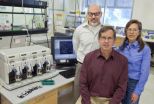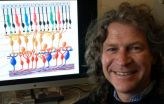(Press-News.org) For much of the time our T cells—the white blood cells that act as the police of the immune system—are in what immunologists call a "quiescent state," a sort of standby mode. For years, scientists have wondered if quiescence occurred by default or whether T cells need to work at remaining silent. Now, researchers at The Wistar Institute provide the first direct proof that a protein, called Foxp1, actively maintains this state of quiescence in T cells until the cells are called upon by other parts of the immune system.
Their findings, which appear online through Nature Immunology ahead of print publication, could one day enable researchers to activate T cells to fight diseases such as cancer, which can go undetected or unrecognized by the immune system. In fact, the researchers report that knocking out the Foxp1 protein in mice activates T cells, allowing the cells to work in their policing function.
"T cell quiescence has been a big mystery in immunology with some obvious and profound implications for treating illness by manipulating the immune system," said Hui Hu, Ph.D., senior author of the study and assistant professor in the Immunology Program at The Wistar Institute. "We believe we have provided evidence that quiescence is not just a passive, default state, and we are now beginning to understand the molecular mechanisms by which it happens."
Mature T cells are generated in the thymus, an organ located in front of heart, and then exit into the periphery. There, these T cells are in a "naïve," quiescent state, awaiting orders to act. Activation primarily requires antigen-presenting cell, which offers up an antigen (a particle that the immune system recognizes as "foreign") to the T cell Receptor (TCR). This activated TCR, then, gives the T cell specificity.
Foxp1 is a transcription factor, a protein that binds to DNA and causes the cell to read—or transcribe—specific genes. The Hu laboratory had previously shown that the Foxp1 protein is important for T cell development in the thymus. In order to understand how Foxp1 operates in mature T cells, the researchers used an inducible deletion model system where they could choose to delete the gene's activity after the cells have already matured.
In studying these Foxp1-less T cells, Hu and his colleagues discovered that naive T cells without Foxp1 become activated and proliferate in response to the protein IL-7, without antigen triggers. Hu and his colleagues discovered that Foxp1 represses the expression of the receptor for IL-7, and some other key signaling, in regulating T cell quiescence.
Foxp1, the researchers found, is similar to a related transcription factor, called Foxo1, a well-studied protein with numerous roles in both cancer and aging. In T cells, Foxo1 helps induce the creation of IL-7 receptors, which allows the T cell to receive the IL-7 signal. Foxp1, they found, directly competed with Foxo1's DNA binding spot, thereby limiting the number of IL-7 receptors each T cell has. Such inter-protein competition helps maintain a balanced state within the cell, Hu says.
Among their key findings, Hu believes, is that removing Foxp1 can cause T cells to proliferate without triggering the TCR. "Antigenic specificity is the key characteristic of T cells and our adaptive immunity," Hu. Said. "We never thought a naive T cell could be activated without stimulation through the T cell receptor."
"It came as such a surprise that the deletion of Foxp1, basically the removal of an essential negative regulation, could lead naive T cells to bypass overt antigen recognition and become activated with effector functions," Hu.
According to Hu, his laboratory, in collaboration with fellow laboratories at Wistar, are now investigating the possibility of knocking out Foxp1 to stimulate T cells in the tumor microenvironment.
"Many cancers cause local T cells to become effectively unresponsive or 'quiescent,' thereby allowing tumors to grow unimpeded by the immune system," Hu said. "We suspect that the tumor cells may 'hijack' the cell-intrinsic quiescence mechanism. In addition, many tumor antigens are poorly immunogenic. By manipulating Foxp1 expression, we may bypass the poor tumor antigen stimulation and restore T cell activation within tumors in the hopes that the immune system will clear away cancerous cells."
###
Funding for this study was provided through grants to Hu from the National Institutes of Health, the American Cancer Society, and The Wistar Institute.
Wistar collaborators include co-first authors postdoctoral fellows Xiaoming Feng, Ph.D., and Haikun Wang, Ph.D., and Hiroshi Takata, Ph.D., and research assistant Timothy J. Day, all of whom are currently members of the Hu lab.
The Wistar Institute is an international leader in biomedical research with special expertise in cancer research and vaccine development. Founded in 1892 as the first independent nonprofit biomedical research institute in the country, Wistar has long held the prestigious Cancer Center designation from the National Cancer Institute. The Institute works actively to ensure that research advances move from the laboratory to the clinic as quickly as possible. The Wistar Institute: Today's Discoveries – Tomorrow's Cures. On the Web at www.wistar.org.
Wistar researchers: Direct proof of how T cells stay in 'standby' mode
Study offers means of activating T cells to fight disease without antigenic triggers
2011-05-08
ELSE PRESS RELEASES FROM THIS DATE:
It takes a community of soil microbes to protect plants from disease
2011-05-08
Those vegetables you had for dinner may have once been protected by an immune system akin to the one that helps you fight disease. Scientists from the U.S. Department of Energy's Lawrence Berkeley National Laboratory (Berkeley Lab) and the Netherland's Wageningen University found that plants rely on a complex community of soil microbes to defend themselves against pathogens, much the way mammals harbor a raft of microbes to avoid infections.
The scientists deciphered, for the first time, the group of microbes that enables a patch of soil to suppress a plant-killing pathogen. ...
Antibodies help protect monkeys from HIV-like virus, NIH scientists show
2011-05-08
WHAT:
Using a monkey model of AIDS, scientists have identified a vaccine-generated immune-system response that correlates with protection against infection by the monkey version of HIV, called simian immunodeficiency virus (SIV). The researchers found that neutralizing antibodies generated by immunization were associated with protection against SIV infection. This finding marks an important step toward understanding how an effective HIV vaccine could work, according to scientists who led the study at the National Institute of Allergy and Infectious Diseases (NIAID), part ...
Anatomy of an outbreak
2011-05-08
GALVESTON, Texas — What causes a virus to suddenly begin infecting large numbers of people?
Scientists have long known that the process they call "viral emergence" involves a wide variety of factors. Some are changes in the environment, either generated by natural causes or human activity. Others are internal, arising from accidental changes — mutations —in the virus' genetic code.
Studying such mutations in different strains of the chikungunya virus has helped University of Texas Medical Branch researchers solve one of the most puzzling mysteries of chikungunya's ...
Forecast calls for nanoflowers to help return eyesight
2011-05-08
EUGENE, Ore. -- University of Oregon researcher Richard Taylor is on a quest to grow flowers that will help people who've lost their sight, such as those suffering from macular degeneration, to see again.
These flowers are not roses, tulips or columbines. They will be nanoflowers seeded from nano-sized particles of metals that grow, or self assemble, in a natural process -- diffusion limited aggregation. They will be fractals that mimic and communicate efficiently with neurons.
Fractals are "a trademark building block of nature," Taylor says. Fractals are objects with ...
DNA from common stomach bacteria minimizes effects of colitis, U-M study says
2011-05-08
ANN ARBOR, Mich. — DNA from Helicobacter pylori, a common stomach bacteria, minimizes the effects of colitis in mice, according to a new study by University of Michigan Medical School scientists.
The study published in Gut this month was performed by a team of investigators assembled by senior author John Y. Kao, M.D. of the University of Michigan's Division of Gastroenterology and assistant professor in U-M's Department of Internal Medicine. The findings indicate that DNA from H. pylori significantly ameliorates the severity of colitis, say lead authors Jay Luther, M.D. ...
When self-esteem is threatened, people pay with credit cards
2011-05-08
Los Angeles, CA - People shop for high status items when they're feeling low, and they're more likely to make those expensive purchases on credit, according to a study in the current Social Psychological and Personality Science (published by SAGE).
When a person's ego is threatened—by doing poorly on a task, by being told they're not as good as they hoped—people sometimes repair their self-worth by purchasing luxury goods. Because actually parting with cash can be psychologically painful, researchers Niro Sivanathan of the London Business School and Nathan Pettit of Cornell ...
No smoking policies may present challenges to treatment centers
2011-05-08
COLUMBUS, Ohio – When a new tobacco-free policy was instituted at an Ohio women's substance abuse treatment center, both smokers and non-smokers were more likely to leave treatment early in the first few months after the policy change, a new study found.
The results don't mean treatment centers shouldn't try smoking bans, according to the researchers, but they do highlight the challenges involved with implementing a new policy that goes against years of conventional thinking.
Researchers found that the number of patients who completed a program at the women's treatment ...
Study probes sources of Mississippi River phosphorus
2011-05-08
MADISON, WI MAY 5, 2011 – In their eagerness to cut nitrogen and phosphorus pollution in the Mississippi River and Gulf of Mexico, people have often sought simple explanations for the problem: too many large animal operations, for instance, or farmers who apply too much fertilizer, which then flows into waterways.
But according to new modeling research that examined phosphorus loading from all 1768 counties in the Mississippi River Basin (MRB), the true causes aren't nearly so straightforward. Livestock manure is widespread in many MRB counties, for example, but it shows ...
UT Southwestern research reveals how cancer-driving enzyme works
2011-05-08
DALLAS – May 6, 2011 – Cancer researchers at UT Southwestern Medical Center are helping unlock the cellular-level function of the telomerase enzyme, which is linked to the disease's growth.
Their latest findings, published today in Molecular Cell, demonstrate that telomerase repairs chromosomes in one of two ways – depending on whether a cell is dividing normally or if the cell is under stress from enzyme inhibition – and could lead to new or improved cancer-fighting therapies that promote inhibition of this enzyme.
"It's a significant advance in our understanding of ...
Vatican science panel calls attention to the threat of glacial melt
2011-05-08
A panel of some of the world's leading climate and glacier scientists co-chaired by a Scripps Institution of Oceanography, UC San Diego researcher issued a report today commissioned by the Vatican's Pontifical Academy of Sciences citing the moral imperative before society to properly address climate change.
The co-authors of "Fate of Mountain Glaciers in the Anthropocene" list numerous examples of glacial decline around the world and the evidence linking that decline to human-caused changes in climate and air pollution. The threat to the ways of life of people dependent ...
LAST 30 PRESS RELEASES:
Numbers in our sights affect how we perceive space
SIMJ announces global collaborative book project in commemoration of its 75th anniversary
Air pollution exposure and birth weight
Obstructive sleep apnea risk and mental health conditions among older adults
How talking slows eye movements behind the wheel
The Ceramic Society of Japan’s Oxoate Ceramics Research Association launches new international book project
Heart-brain connection: international study reveals the role of the vagus nerve in keeping the heart young
Researchers identify Rb1 as a predictive biomarker for a new therapeutic strategy in some breast cancers
Survey reveals ethical gaps slowing AI adoption in pediatric surgery
Stimulant ADHD medications work differently than thought
AI overestimates how smart people are, according to HSE economists
HSE researchers create genome-wide map of quadruplexes
Scientists boost cell "powerhouses" to burn more calories
Automatic label checking: The missing step in making reliable medical AI
Low daily alcohol intake linked to 50% heightened mouth cancer risk in India
American Meteorological Society announces Rick Spinrad as 2026 President-Elect
Biomass-based carbon capture spotlighted in newly released global climate webinar recording
Illuminating invisible nano pollutants: advanced bioimaging tracks the full journey of emerging nanoscale contaminants in living systems
How does age affect recovery from spinal cord injury?
Novel AI tool offers prognosis for patients with head and neck cancer
Fathers’ microplastic exposure tied to their children’s metabolic problems
Research validates laboratory model for studying high-grade serous ovarian cancer
SIR 2026 delivers transformative breakthroughs in minimally invasive medicine to improve patient care
Stem Cell Reports most downloaded papers of 2025 highlight the breadth and impact of stem cell research
Oxford-led study estimates NHS spends around 3% of its primary and secondary care budget on the health impacts of heat and cold in England
A researcher’s long quest leads to a smart composite breakthrough
Urban wild bees act as “microbial sensors” of city health.
New study finds where you live affects recovery after a hip fracture
Forecasting the impact of fully automated vehicle adoption on US road traffic injuries
Alcohol-related hospitalizations from 2016 to 2022
[Press-News.org] Wistar researchers: Direct proof of how T cells stay in 'standby' modeStudy offers means of activating T cells to fight disease without antigenic triggers


